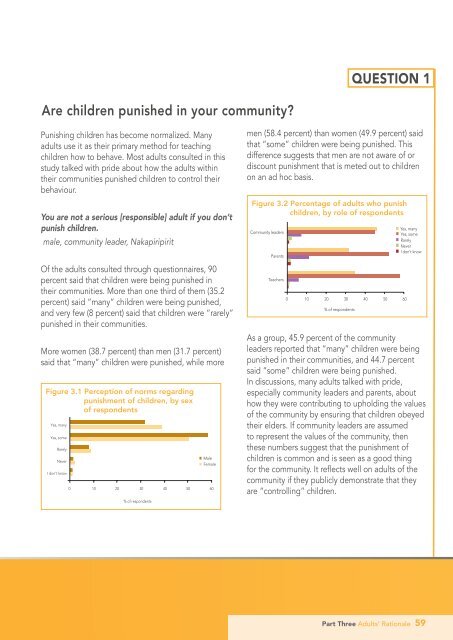Violence against children, the voices of Ugandan ... - Raising Voices
Violence against children, the voices of Ugandan ... - Raising Voices
Violence against children, the voices of Ugandan ... - Raising Voices
Create successful ePaper yourself
Turn your PDF publications into a flip-book with our unique Google optimized e-Paper software.
QUESTION 1Are <strong>children</strong> punished in your community?Punishing <strong>children</strong> has become normalized. Manyadults use it as <strong>the</strong>ir primary method for teaching<strong>children</strong> how to behave. Most adults consulted in thisstudy talked with pride about how <strong>the</strong> adults within<strong>the</strong>ir communities punished <strong>children</strong> to control <strong>the</strong>irbehaviour.You are not a serious [responsible] adult if you don’tpunish <strong>children</strong>.male, community leader, NakapiripiritOf <strong>the</strong> adults consulted through questionnaires, 90percent said that <strong>children</strong> were being punished in<strong>the</strong>ir communities. More than one third <strong>of</strong> <strong>the</strong>m (35.2percent) said “many” <strong>children</strong> were being punished,and very few (8 percent) said that <strong>children</strong> were “rarely”punished in <strong>the</strong>ir communities.More women (38.7 percent) than men (31.7 percent)said that “many” <strong>children</strong> were punished, while moreFigure 3.1 Perception <strong>of</strong> norms regardingpunishment <strong>of</strong> <strong>children</strong>, by sex<strong>of</strong> respondentsYes, manyYes, someRarelyNeverI don’t know010 20% <strong>of</strong> respondentsMaleFemale30 40 50 60men (58.4 percent) than women (49.9 percent) saidthat “some” <strong>children</strong> were being punished. Thisdifference suggests that men are not aware <strong>of</strong> ordiscount punishment that is meted out to <strong>children</strong>on an ad hoc basis.Figure 3.2 Percentage <strong>of</strong> adults who punish<strong>children</strong>, by role <strong>of</strong> respondentsCommunity leadersParentsTeachers0 10 20 30 40 50 60% <strong>of</strong> respondentsYes, manyYes, someRarelyNeverI don’t knowAs a group, 45.9 percent <strong>of</strong> <strong>the</strong> communityleaders reported that “many” <strong>children</strong> were beingpunished in <strong>the</strong>ir communities, and 44.7 percentsaid “some” <strong>children</strong> were being punished.In discussions, many adults talked with pride,especially community leaders and parents, abouthow <strong>the</strong>y were contributing to upholding <strong>the</strong> values<strong>of</strong> <strong>the</strong> community by ensuring that <strong>children</strong> obeyed<strong>the</strong>ir elders. If community leaders are assumedto represent <strong>the</strong> values <strong>of</strong> <strong>the</strong> community, <strong>the</strong>n<strong>the</strong>se numbers suggest that <strong>the</strong> punishment <strong>of</strong><strong>children</strong> is common and is seen as a good thingfor <strong>the</strong> community. It reflects well on adults <strong>of</strong> <strong>the</strong>community if <strong>the</strong>y publicly demonstrate that <strong>the</strong>yare “controlling” <strong>children</strong>.Part Three Adults’ Rationale 59
















